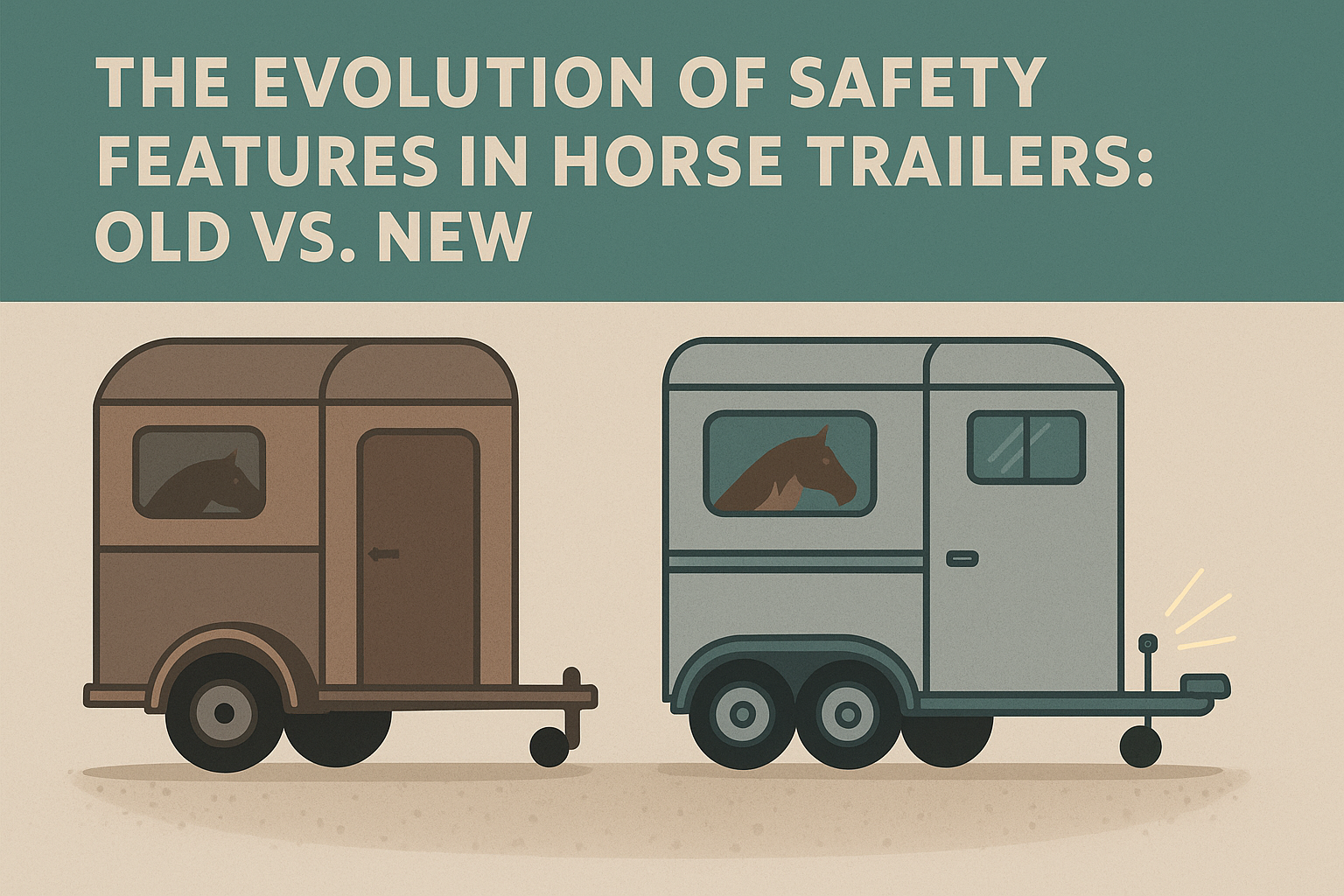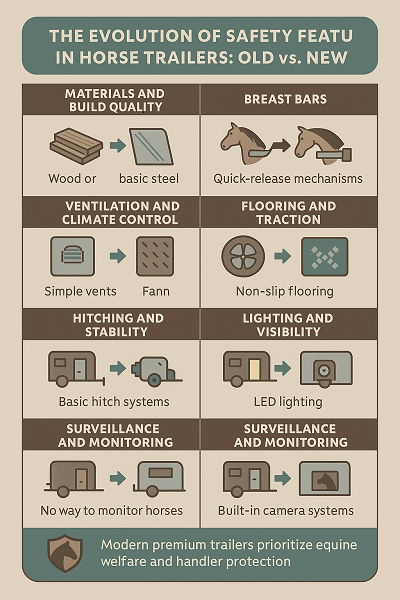The Evolution of Safety Features in Horse Trailers: Old vs. New
Transporting horses safely has always been a priority for equestrians, yet the equipment used for this task has seen significant evolution over the years. Horse trailers, especially those built before the 2000s or in the budget range, were often designed with minimal safety features, focusing more on basic transport rather than equine welfare and emergency preparedness. In contrast, modern premium trailers are engineered with advanced safety systems that cater to both horses and handlers. This blog post explores the major differences in safety features between older, cheaper horse trailers and the more advanced models available today.
The Basics of Horse Trailer Safety
Horse trailer safety can be divided into three main areas:
Structural Integrity and Materials
Horse Containment and Restraint
Emergency Access and Release Mechanisms
Older trailers typically fell short in at least one of these areas, while modern trailers aim to address all three comprehensively.
Materials and Build Quality
In the past, horse trailers were often built from wood or basic steel. These materials, while sturdy, were prone to rot (in the case of wood) or rust (in the case of untreated steel) and generally lacked longevity without constant maintenance. The floors, in particular, were a critical failure point. Stories of horses falling through weakened trailer floors were unfortunately not uncommon in older models .
Today’s higher-end trailers use aluminium alloys, galvanised steel, or composite flooring systems that are lighter, stronger, and more resistant to environmental damage. These not only reduce trailer weight—improving fuel efficiency and wear on towing vehicles—but also enhance the long-term safety of the horse by ensuring structural integrity for years .
Breast Bars and Emergency Release Features
Older trailers were often equipped with fixed breast bars or ones that required tools and multiple steps to remove. This made it extremely difficult to assist a horse that had reared up or gotten stuck over a bar—an unfortunately common incident in stressed or unbalanced horses .
Modern trailers now incorporate quick-release breast bars, often spring-loaded or latch-based, that can be released from outside the trailer within seconds. This design allows for swift action in an emergency, minimising injury to both horse and handler .
Some modern products, such as the ESR Bar, take this a step further by providing tool-free emergency release mechanisms that reduce the need for cutting equipment or specialist tools—an especially important consideration when time is critical during roadside incidents or accidents .
Ventilation and Climate Control
Ventilation is critical in preventing stress and heat stroke in transported horses. Many older trailers relied on rudimentary ventilation systems—such as small sliding windows or roof vents—that were often insufficient on hot days or during longer journeys .
In contrast, newer models feature cross-ventilation designs, integrated fans, and insulated ceilings to maintain more consistent internal temperatures. Some high-end trailers even offer climate control systems to regulate heat and airflow automatically, enhancing equine comfort and reducing travel-related stress .
Flooring and Traction
Slippery surfaces have been a persistent danger in older trailers. Basic rubber mats laid over steel or wooden floors often shifted during transit or became waterlogged and moldy, creating hazardous footing for horses .
Modern trailers now incorporate non-slip rubberized flooring, drainage channels, and sealed, bonded mats that provide superior grip, reduce odor build-up, and improve hygiene. These developments not only make the journey safer for the horse but also ease maintenance for owners.
Hitching and Stability
Many older budget trailers were built with basic hitch systems and minimal attention to balance and weight distribution. This sometimes led to trailer sway, a dangerous condition where the trailer fishtails behind the towing vehicle, increasing the risk of accidents .
Contemporary trailers often feature anti-sway technology, independent suspension systems, and weight-distributing hitches to improve towing stability. Some manufacturers have also introduced automatic braking systems and camera-assisted towing, giving drivers more control and awareness on the road .
Lighting and Visibility
Another major area of improvement has been in interior and exterior lighting. Older trailers often had poor lighting, making it difficult to load horses at night or for other road users to notice the trailer.
Modern designs typically feature LED lighting, reflective safety markings, and interior lights that can be operated remotely. This boosts safety during loading/unloading and while driving in low-visibility conditions .
Surveillance and Monitoring
Technology now plays a major role in trailer safety. In older trailers, once the doors were shut, owners had no way of monitoring the horse’s behaviour until they stopped and opened the doors.
Today, many higher-end trailers come with built-in camera systems that allow the driver to monitor the horse in real-time. Some even offer temperature sensors and motion alerts, giving handlers peace of mind throughout the journey .
Cost vs. Safety: Are Expensive Trailers Worth It?
While premium trailers can cost significantly more—often double or triple the price of older or second-hand models—the safety enhancements they offer may justify the investment, especially for frequent transporters or high-value animals. Budget-conscious owners don’t have to be left behind, however. Many modern safety features—such as quick-release bars or non-slip flooring—can now be retrofitted into older trailers.
Products like the ESR Bar represent a growing market for aftermarket safety upgrades that can transform basic trailers into safer environments without needing to purchase a brand-new unit .
Final Thoughts
The evolution of horse trailer safety reflects a broader trend toward equine welfare and handler protection. While older trailers often did the job with the bare minimum, modern designs are driven by decades of learning, technology, and demand for better care. Investing in safer equipment not only reduces risk but demonstrates a commitment to responsible horse ownership.
Whether through a new trailer purchase or safety retrofitting, ensuring your trailer is equipped with modern features can make all the difference in a moment of crisis.
Sources
Equus Magazine. “Trailer Floor Failures: What You Need to Know.” Equus, 2019.
Double D Trailers. “Horse Trailer Construction: Steel vs. Aluminum.” Double D, 2021.
Horse and Hound. “Common Horse Trailer Accidents and How to Avoid Them.” Horse & Hound, 2022.
TheHorse.com. “Safety Features You Need in a Horse Trailer.” TheHorse, 2020.
ESRBar.com. “The ESR Bar: Emergency Release for Horse Trailers.” ESRBar, 2024.
University of Kentucky. “Horse Trailer Ventilation Tips.” UKY Equine Programs, 2018.
EquiSpirit. “Ventilation and Horse Trailer Design.” EquiSpirit, 2021.
Horse Journals. “Safe Trailer Flooring for Horses.” Horse Journals, 2020.
National Highway Traffic Safety Administration. “Trailer Sway and How to Prevent It.” NHTSA, 2020.
Boeckmann Trailers. “Technology in Modern Horse Trailers.” Boeckmann, 2023.
USRider. “Horse Trailer Safety Lighting.” USRider Equestrian Motor Plan, 2019.
Trailer Eyes. “Wireless Horse Trailer Cameras.” Trailer Eyes, 2023.
Source: Generated by ChatGPT using DALL·E (OpenAI), 2025.



